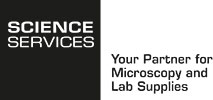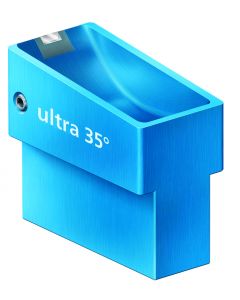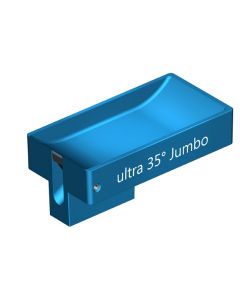ultra
(18)45° is acknowledged as the appropriate knife angle for routine sectioning of both biological and material samples, it represents a balanced compromise between section quality and durability.
For the sectioning of a number of hard materials such as ceramics, semiconductors, oxides with the use of the ultra 45° knife a longer service time may be expected.
Usage of 35° knives considerably leads to reduced compression, smoother section surfaces and improved structural preservation.
Ultra 35° knives are perfect for sectioning relatively soft materials research specimens including metals and polymers, as well as mixed specimens such as polymers filled with nanoparticles, brittle materials such as catalysts, crystals, semiconductors, etc.
The ultra 35° knife has demonstrated its usefulness as a standard knife for the majority of applications in both biological and materials research.
-
Starting at
The ultra 35° knife has demonstrated it's usefulness as a standard knife for the majority of applications in both biological and materials research. The 35° knife offers reduced compression, smoother section surfaces and improved structural preservation.Starting at
-
Starting at
The ultra 35° knife has demonstrated it's usefulness as a standard knife for the majority of applications in both biological and materials research. The 35° knife offers reduced compression, smoother section surfaces and improved structural preservation.Starting at
-
Starting at
The ultra 35° knife has demonstrated it's usefulness as a standard knife for the majority of applications in both biological and materials research. The 35° knife offers reduced compression, smoother section surfaces and improved structural preservation.Starting at
-
Starting at
The ultra 35° knife has demonstrated it's usefulness as a standard knife for the majority of applications in both biological and materials research. The 35° knife offers reduced compression, smoother section surfaces and improved structural preservation.Starting at
-
Starting at
The ultra 35° knife has demonstrated it's usefulness as a standard knife for the majority of applications in both biological and materials research. The 35° knife offers reduced compression, smoother section surfaces and improved structural preservation.Starting at
-
Starting at
The ultra 35° knife has demonstrated it's usefulness as a standard knife for the majority of applications in both biological and materials research. The 35° knife offers reduced compression, smoother section surfaces and improved structural preservation.Starting at
-
Starting at
The DiATOME ultra ats was developed for mounting series of ultra-thin sections directly on (conductive) substrates such as silicon wafers or ITO slides. Using Array Tomography 3D data sets of the section series can be recorded by subsequent SEM imaging. The large knife boat is equipped with a water outlet at the bottom.Starting at
-
Starting at
The ultra semi 35° knife has demonstrated it's usefulness as a standard knife for the majority of applications in both biological and materials research. The ultra semi knife will work for alternating sectioning with a cutting range from 50-500nm.Starting at
-
Starting at
-
Starting at
-
Starting at
Acknowledged as the appropriate knife angle for routine sectioning of both biological and material research specimens, it represents a balanced compromise between section quality and durability.Starting at
-
Starting at
Acknowledged as the appropriate knife angle for routine sectioning of both biological and material research specimens, it represents a balanced compromise between section quality and durability.Starting at
-
Starting at
Acknowledged as the appropriate knife angle for routine sectioning of both biological and material research specimens, it represents a balanced compromise between section quality and durability.Starting at
-
Starting at
Acknowledged as the appropriate knife angle for routine sectioning of both biological and material research specimens, it represents a balanced compromise between section quality and durability.Starting at
-
Starting at
Acknowledged as the appropriate knife angle for routine sectioning of both biological and material research specimens, it represents a balanced compromise between section quality and durability.Starting at
-
Starting at
Acknowledged as the appropriate knife angle for routine sectioning of both biological and material research specimens, it represents a balanced compromise between section quality and durability.Starting at
-
Starting at
-
Starting at










